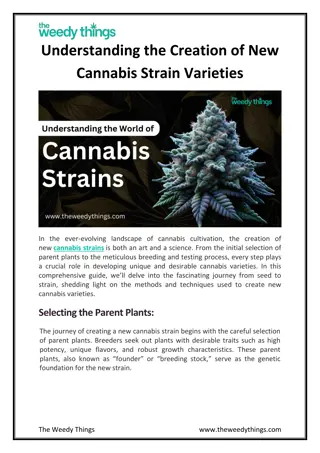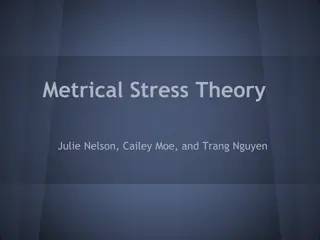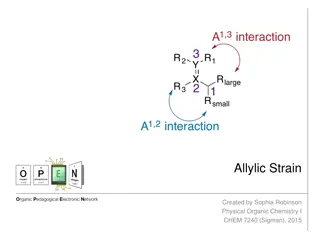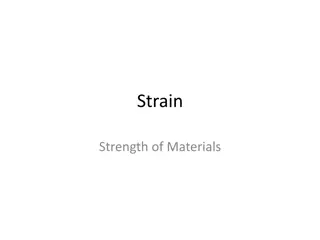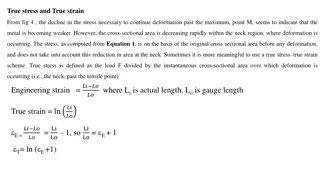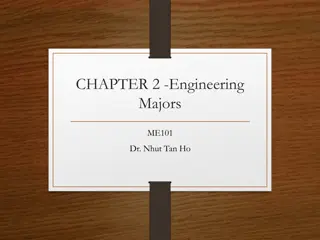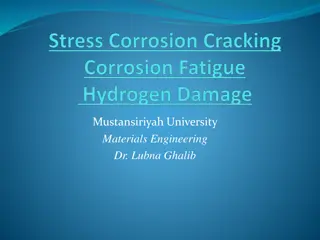Understanding Stress-Strain Behavior in Mechanical Engineering
The article explores the concepts of strain, stress, and the stress-strain diagram in mechanical engineering. It covers topics such as Hooke's Law, elastic limit, and the elastic and plastic ranges in materials. Various diagrams and explanations offer insights into the behavior of materials under different loads and deformations.
Download Presentation

Please find below an Image/Link to download the presentation.
The content on the website is provided AS IS for your information and personal use only. It may not be sold, licensed, or shared on other websites without obtaining consent from the author. Download presentation by click this link. If you encounter any issues during the download, it is possible that the publisher has removed the file from their server.
E N D
Presentation Transcript
Al-Mustansiryah University Mechanical Engineering Department Strain Part 1 : theory By Dr Abbas Ahmed Al-Asady
Strain Simple Strain Simple Strain Also known as unit deformation, strain is the ratio of the change in length caused by the applied force, to the original length. where is the deformation and L is the original length, thus is dimensionless.
Stress Stress- -Strain Diagram Strain Diagram Suppose that a metal specimen be placed in tension-compression testing machine. As the axial load is gradually increased in increments, the total elongation over the gage length is measured at each increment of the load and this is continued until failure of the specimen takes place. Knowing the original cross-sectional area and length of the specimen, the normal stress and the strain can be obtained. The graph of these quantities with the stress along the y-axis and the strain along the x-axis is called the stress-strain diagram. The stress-strain diagram differs in form for various materials. The diagram shown below is that for a medium carbon structural steel. Metallic engineering materials are classified as either ductile or brittle materials. A ductile material is one having relatively large tensile strains up to the point of rupture like structural steel and aluminum, whereas brittle materials has a relatively small strain up to the point of rupture like cast iron and concrete. An arbitrary strain of 0.05 mm/mm is frequently taken as the dividing line between these two classes.
Stress Stress- -Strain Diagram Strain Diagram
PROPORTIONAL LIMIT (HOOKE'S LAW) PROPORTIONAL LIMIT (HOOKE'S LAW) From the origin O to the point called proportional limit, the stress-strain curve is a straight line. This linear relation between elongation and the axial force causing was first noticed by Sir Robert Hooke in 1678 and is called Hooke's Law that within the proportional limit, the stress is directly proportional to strain or The constant of proportionality k is called the Modulus of Elasticity E or Young's Modulus and is equal to the slope of the stress-strain diagram from O to P. Then
ELASTIC LIMIT: ELASTIC LIMIT: The elastic limit is the limit beyond which the material will no longer go back to its original shape when the load is removed, or it is the maximum stress that may e developed such that there is no permanent or residual deformation when the load is entirely removed. ELASTIC AND PLASTIC RANGES: The region in stress-strain diagram from O to P is called the elastic range. The region from P to R is called the plastic range.
YIELD POINT: YIELD POINT: Yield point is the point at which the material will have an appreciable elongation or yielding without any increase in load. ULTIMATE STRENGTH: ULTIMATE STRENGTH: The maximum ordinate in the stress-strain diagram is the ultimate strength or tensile strength. RAPTURE STRENGTH: RAPTURE STRENGTH: Rapture strength is the strength of the material at rupture. This is also known as the breaking strength.
MODULUS OF RESILIENCE: MODULUS OF RESILIENCE: Modulus of resilience is the work done on a unit volume of material as the force is gradually increased from O to P, in Nm/m3. This may be calculated as the area under the stress-strain curve from the origin O to up to the elastic limit E (the shaded area in the figure). The resilience of the material is its ability to absorb energy without creating a permanent distortion. MODULUS OF TOUGHNESS: MODULUS OF TOUGHNESS: Modulus of toughness is the work done on a unit volume of material as the force is gradually increased from O to R, in Nm/m3. This may be calculated as the area under the entire stress-strain curve (from O to R). The toughness of a material is its ability to absorb energy without causing it to break.
WORKING STRESS, ALLOWABLE STRESS, AND WORKING STRESS, ALLOWABLE STRESS, AND FACTOR OF SAFETY: FACTOR OF SAFETY: Working stress is defined as the actual stress of a material under a given loading. The maximum safe stress that a material can carry is termed as the allowable stress. The allowable stress should be limited to values not exceeding the proportional limit. However, since proportional limit is difficult to determine accurately, the allowable tress is taken as either the yield point or ultimate strength divided by a factor of safety. The ratio of this strength (ultimate or yield strength) to allowable strength is called the factor of safety. AXIAL DEFORMATION: AXIAL DEFORMATION: In the linear portion of the stress-strain diagram, the tress is proportional to strain and is given by:
since = P / A and e= / L, then P / A = E / L. Solving for , To use this formula, the load must be axial, the bar must have a uniform cross- sectional area, and the stress must not exceed the proportional limit. If however, the cross-sectional area is not uniform, the axial deformation can be determined by considering a differential length and applying integration. If however, the cross-sectional area is not uniform, the axial deformation can be determined by considering a differential length and applying integration.
where A = ty and y and t, if variable, must be expressed in terms of x. For a rod of unit mass suspended vertically from one end, the total elongation due to its own weight is where is in kg/m3, L is the length of the rod in mm, M is the total mass of the rod in kg, A is the cross-sectional area of the rod in mm2, and g = 9.81 m/s2. STIFFNESS, k: STIFFNESS, k: Stiffness is the ratio of the steady force acting on an elastic body to the resulting displacement. It has the unit of N/mm.







